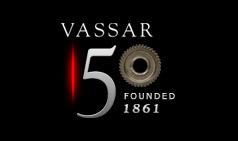The History of the Independent Program at Vassar College
by Heesok Chang, Associate Professor of English
January 2011
Program Website
What role does an Independent Program major play in a liberal arts curriculum, which (as the term "liberal" implies) already encompasses notions of open-mindedness, flexibility, scope, and invention? Don't existing liberal arts majors offer quite enough intellectual freedom? Why would a student need even more "independence"? The answers to these questions lie in the origins of the Program.
The Independent Program at Vassar was launched at the close of the volatile 1960s when college and university campuses across the globe became key sites of political and cultural contestation. Widespread student demand for sweeping changes to academic life – coeducation, liberalized rules of conduct, curricular flexibility and innovation – was integrally linked to larger social struggles: the free speech movement, civil rights, feminism, the Vietnam War. Vassar had been a women's college since its founding in 1861. Mounting internal and external pressure for coeducation led to serious consideration about merging with Yale University.
The decision to relocate the campus from Poughkeepsie to New Haven was rejected, but as part of a larger conversation about modernizing the college not only was coeducation instituted at Vassar in 1969, so too was a radically new curricular structure. Students now had the option of selecting one of three paths to their bachelor's degree: 1. concentration in a discipline (choosing a traditional major); 2. a multidisciplinary program (including such new fields of study as Man and the Human Community, Language and Communication, Arts and Society, and East Asian Studies); and 3. an Independent program, which consisted largely of courses, independent studies, designed in conjunction with a faculty advisor. By way of anecdote, an emeritus professor tells the story of meeting with a thoughtful, luminous young student who was torn between majoring in Drama or English asked him if she could somehow do both. Together they chartered a novel course of study, including new classes that would combine performance and literature. She applied and was accepted to the Independent Program. This independent-minded student was named Meryl Streep.
Today the Independent Program does not loom quite so large in the structure of the curriculum; the very idea of a tripartite curriculum is defunct. But the experimental spirit of the program remains. It continues to act as an inviting blank canvas, a place in the college curriculum where new, emerging fields of inquiry may be given a few trial runs. One of the reasons Vassar boasts so many interdepartmental and multidisciplinary programs is because they were able to develop and gain momentum under the auspices of the Independent Program. Thus the program is a good place for the college as a whole to track curricular trends. For example, Peace and Conflict Studies and Linguistics are areas of study that have no formal residence at Vassar but do so at other colleges and universities. A core group of professors at Vassar who do work in these fields actively mentor interested advisees through the Independent Program.
Of course, the Independent Program does not primarily serve faculty interests. Its main purpose is to allow students to major in a multidisciplinary study that cannot be accommodated by an existing program or department. At Vassar, departments house (at least nominally) single, traditionally established disciplines like English and Art History, German and Japanese, Physics and Biology, Computer Science and Film, Sociology and Political Science. All tenure-line faculty members at the college are hired by and belong to a department. Programs are interdepartmental or multidisciplinary entities that are staffed by faculty members on loan, as it were, from their home departments. Since the late sixties, the number of programs has exploded. Examples of interdepartmental programs are Biochemistry, Neuroscience and Behavior, Physics and Astronomy, Geography-Anthropology, Medieval and Renaissance Studies, and Victorian Studies. Multidisciplinary programs include: Asian Studies, American Culture, Africana Studies, Jewish Studies, International Studies, Cognitive Science, Environmental Studies, Urban Studies, Media Studies, and Science, Technology, and Society.
As this list might suggest, Vassar offers an unusually high number of single-disciplinary, interdisciplinary, and multidisciplinary options from which students may select their field of concentration. Given the dynamic, ever-evolving nature of the Vassar College curriculum, this rich menu will no doubt continue to change. And doubtless this change will be effected, in part, by the intrepid programs of study of our Independent majors. Some recently approved Independent Programs include: Peace and Conflict Studies, Ethnic and National Identity in the Middle East, Islamic Studies, Development and Growth in the Third World, Cognitive Analysis of Political History, Neurolinguistics, Cultural Linguistics, Philosophy of Biology, Biochemical Visualization, Forensic Archaeology, Education Policy, Arts Education and Social Change, Urban Social Welfare, Racial Identity Construction, Children and the Law in America, Food in Society and the Environment, Art and Feminism, Art and Social Change, Architectural Studies, Comparative Literature, Critical Theory, Modernism and Modernity, Literature and Philosophy, Feminist Theory and Literature, Science Fiction, Folkore, Myth Studies, European Studies, Philosophy of Dance, Creative Drama in the Classroom, Technology and Global Development.
